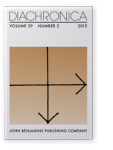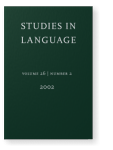Matthias Gerner
List of John Benjamins publications for which Matthias Gerner plays a role.
2020 Zero morphemes in paradigms Studies in Language 44:1, pp. 1–26 | Article
This paper sheds a new light on the notion of zero morphemes in inflectional paradigms: on their formal definition (§ 1), on the way of counting them (§ 2–3) and on the way of conceptualizing them at a deeper, mathematical level (§ 4). We define (zero) morphemes in the language of cartesian set… read more
2019 Chapter 24. Towards diachronic word classes universals Historical Linguistics 2015: Selected papers from the 22nd International Conference on Historical Linguistics, Naples, 27-31 July 2015, Cennamo, Michela and Claudia Fabrizio (eds.), pp. 501–518 | Chapter
In this paper we examine the correlation of variables that influence the process of grammaticalization or lexicalization of a word class. Word classes change when all members change in a coordinated way. From the study of 24 word classes originating from representative languages in the world, we… read more
2014 Verb classifiers in East Asia Functions of Language 21:3, pp. 267–296 | Article
Many linguists define classification systems in terms of semantic profiling. The classifier profiles a semantic trait common to all the classified items. This paper rejects semantic profiling in favor of a combinatorial definition of classification and evaluates verb classification in five… read more
2012 Historical change of word classes Diachronica 29:2, pp. 162–200 | Article
This paper isolates four parameters that guide the historical change of word classes: the quantificational parameter, the directional parameter, the preservative parameter and the temporal parameter. These parameters are involved in the organization of seven case studies in East Asian languages.… read more
2002 Perfect in the Yi group: Stative and dynamic information management Studies in Language 26:2, pp. 337–368 | Article
The languages of the Yi group shed new light on the Perfect forms of other languages through their perfect particles. Several Yi languages display two perfect particles which unite in one paradigmatic picture the English type and the Mandarin type. I will first present Liangshan Nuosu’s ta33… read more




